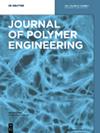Enhancement of the tribological and thermal properties of UHMWPE based ternary nanocomposites containing graphene and titanium titride
IF 1.7
4区 工程技术
Q4 POLYMER SCIENCE
引用次数: 0
Abstract
Ultra-high molecular weight polyethylene (UHMWPE) generally does not have high resistance to wear and are characterised by poor thermal stability when exposed to long working condition. To address these shortcomings, this study used hybrid graphene nanoplatelets (GN) and titanium nitride (TiN) nanoparticles to significantly enhance the wear resistance and thermal stability of UHMWPE. The nanocomposites were prepared by solvent mixing and hot compression process. Scanning electron microscope showed uniform dispersion of the nanoparticles in the UHMWPE matrix. The developed UHMWPE showed improved wear resistance and thermal stability relative to the pure UHMWPE. For instance, the wear rate reduced from 6.7 × 10增强含有石墨烯和氮化钛的超高分子量聚乙烯基三元纳米复合材料的摩擦学性能和热性能
超高分子量聚乙烯(UHMWPE)的耐磨性通常不高,而且在长期工作条件下热稳定性较差。针对这些缺点,本研究采用混合石墨烯纳米片(GN)和氮化钛(TiN)纳米颗粒来显著提高超高分子量聚乙烯的耐磨性和热稳定性。纳米复合材料是通过溶剂混合和热压工艺制备的。扫描电子显微镜显示纳米粒子均匀地分散在超高分子量聚乙烯基体中。与纯超高分子量聚乙烯相比,所开发的超高分子量聚乙烯具有更好的耐磨性和热稳定性。例如,在施加 10 N 和 20 N 负载时,UHMWPE-2 wt% GN-10 wt% TiN 的磨损率分别从纯 UHMWPE 的 6.7 × 10-3 mm3 N-1 m-1 和 3.67 × 10-2 mm3 N-1 m-1 降低到 2.687 × 10-5 mm3 N-1 m-1 和 1.34 × 7 × 10-4 mm3 N-1 m-1。与纯超高分子量聚乙烯相比,在相应载荷下的耐磨性提高了约 100%。使用热重分析仪(TGA)研究了纳米复合材料的热稳定性。纳米颗粒的加入大大降低了超高分子量聚乙烯基体的热分解。超高分子量聚乙烯-GN-TiN 纳米复合材料性能的增强可能是由于 GN 和 TiN 纳米粒子在超高分子量聚乙烯基体中的分散形成了网络结构,促进了分子链的交锁。
本文章由计算机程序翻译,如有差异,请以英文原文为准。
求助全文
约1分钟内获得全文
求助全文
来源期刊

Journal of Polymer Engineering
工程技术-高分子科学
CiteScore
3.20
自引率
5.00%
发文量
95
审稿时长
2.5 months
期刊介绍:
Journal of Polymer Engineering publishes reviews, original basic and applied research contributions as well as recent technological developments in polymer engineering. Polymer engineering is a strongly interdisciplinary field and papers published by the journal may span areas such as polymer physics, polymer processing and engineering of polymer-based materials and their applications. The editors and the publisher are committed to high quality standards and rapid handling of the peer review and publication processes.
 求助内容:
求助内容: 应助结果提醒方式:
应助结果提醒方式:


